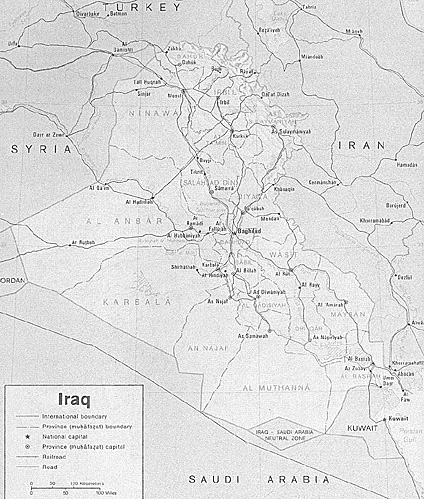 GEOGRAPHY AND CLIMATE
GEOGRAPHY AND CLIMATE
Iraq's geography is discussed in terms of four main regions: the desert in the west and southwest; the rolling upland between the Tigris and Euphrates rivers (in Arabic, the Dijhis and Furat, respectively); the highlands in the northeast; and the central and southeastern alluvial plain through which the Tigris and Euphrates flow. Iraq's total land area is approximately 435,000 square kms.
Jumbo Map: Iraq (extremely slow: 510K)
The desert zone, lying west and southwest of the Euphrates river, is a part of the Syrian Desert. The region is sparsely populated and consists of a wide stoney plain interspersed with rare sandy stretches. A widely ramified pattern of wadis runs from the border to the Euphrates. Some wadis are more than 400 kms long, and carry brief, but torrential, floods during the winter rains.
The uplands region, between the Tigris north of Samarra and the Euphrates north of Hit, is known as Al Jazirah and is part of a larger area that extends westward into Syria, between the two rivers, and into Turkey. Water in the area flows in deeply cut valleys. Much of this zone may be classified as desert.
The northeastern highlands begin just south of a line drawn from Mosul to Kirkuk, and they extend to the borders with Turkey and Iran. High grounds, separated by broad, undulating steppes, give way to mountains ranging from 1,000 to 4,000 m near the borders. Except for a few valleys, the mountain area proper is suitable only for grazing in the foothills and steppes; adequate soil and rainfall make cultivation possible. Iraq's largest oil fields are located near Mosul and Kirkuk.
The alluvial plain begins north of Bagdad and extends to the Persian Gulf. The Tigris and Euphrates rivers lie above the level of the plain in many areas in this region. The whole area is a delta interlaced by the channels of the two rivers and by irrigation canals. Intermittent lakes, fed by the rivers in flood, also characterize southeastern Iraq. A fairly large area just above the merging of the two rivers at Al Qurnah and extending east of the Tigris beyond the Iranian Border is marshland, known as the Hawr al Hammerar. Much of it is permanent marsh, but some parts dry out in early winter, and other parts become marshland only in years of great flood.
Roughly 90 percent of the annual rainfall occurs between November and April, most of it in the winter months from December through March. The remaining 6 months, particularly the hottest ones of June, July, and August, at approximately 102 degrees F, are dry. The summer months are marked by two types of wind. The southerly and southeasternly Sharqi, a dry, dusty wind with occasional gusts of 80 km an hour, occurs from April to early June and again from late September through November.
From mid-June to mid-September, the prevailing wind, called the Shamal, is from the north and northwest. It is a steady wind, absent only occasionally during this period. The very dry air brought by this Shamal permits intensive heating of the land surface by the sun, but the breeze has some cooling effect.
Back to Table of Contents -- Winning in the Desert
Back to CALL List of Issues
Back to MagWeb Magazine List
© Copyright 2004 by Coalition Web. Inc.
This article appears in MagWeb.com (Magazine Web) on the Internet World Wide Web.
Other articles from military history and related magazines are available at http://www.magweb.com